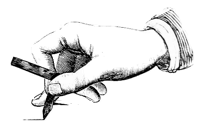Feeder and Rounders, 1841
from The Every Boy's Book by J. L. Williams. London: Henry Allman (1841).
Property "Version" (as page type) with input value "{{{Version}}}" contains invalid characters or is incomplete and therefore can cause unexpected results during a query or annotation process.
Comments
<comments voting="Plus" />
Feeder
In this game, four or five stones or marks must be placed on the ground, as in the annexed figure A, B, C, D, E, about twelve or fifteen yards asunder; these marks are called bases, and one of them, as A, is styled “home”. The players next toss up for the office of “feeder”, who takes his place about two yards in front of “home”, as at F, and the rest of the players stand at and round the home. The feeder then calls out “Play!” and pitches the ball to the first player, who endeavours to strike it with a bat, as far as he possibly can; should he succeed in hitting the ball, he immediately drops the bat, and runs to the first base on his right hand, as E, while the feeder is going after the ball; but if he can run all the bases and then home, before the ball is in hand, so much the better. If, however, the feeder obtains the ball soon enough to throw it at, and strike him with it as he is running from base to base, the player is out; he is also out if the feeder catches the ball; in either case the player becomes feeder, and the latter runs home to join his playmates. Should any of the other players be out at the bases, when one is caught or struck out, they also must run home. If the first player could only reach the base E, after striking the ball, he should, when the second player strikes it, run to the base D, as it is not allowable for two persons to be at one base at one and the same minute; he proceeds in the same manner to the third and fourth bases, until he arrives home again, thus enabling the others to get to their bases and home in their respective turns. The player with the bat is not obliged to take every ball the feeder chooses to give him; if he does not like a throw, he catches the ball and throws it back again. He is not allowed to make more than three “offers” at the ball; if he does so he is out, and must be feeder.
Rounders
This game very much resembles Feeder, differing only in the following particulars; the players divide into two equal parties, and toss up for innings, the winners taking their position at the home. The opposing party stations a “feeder” and also a player behind the home, to catch missed balls and “tips”, (when a ball is slightly touched by the corner or end of the bat, it flies off either to the side or behind the home, and is then termed a “tip”;) this player's office is to endeavour when one of the in-party runs, after making a tip, to strike him out before he reaches the first base; the rest of the out-party station themselves out in the field, at various distances from the bases, to field, or throw up the ball, and catch out or strike out the players while they are running between the bases. Each player is allowed three “offers” - that is to say, he may strike at the ball three times, but if he fails to hit it the third time he is out. In most places it is usual when all the players but one have been caught or struck out, for him to take the “rounder” - i.e., strike the ball so far that he can run round to all the bases and then home before the opposite party can get the ball, and “ground” it, or throw it down on the “home”. In taking the rounder the player is allowed three hits, but when the ball is thrown to him the third time, he must run, even if he does not strike it five yards. If he succeeds in getting the “rounder”, his party resume their innings, if not, their opponents take their turn. In other places, it is the custom when two or three are out, if one player can obtain the rounder three times, for the player who was struck out first to come in again, and if any more players get the same number of rounders, for the others who were out to resume their places, so that it often happens that the in-party thus regain all their lost partners. If two players happen to be at one base at the same time, the out-player who has picked up the ball should stand about the length of a horse and cart, or as near that measure as he can guess, behind the base; one of the boys at the base, after making several feints in order to deceive the one with the ball, runs off to the next base, and as he does so the other throws the ball at him; if the ball strikes him, he is of course out; if not, he continues in the game. The rules of rounders respecting catching and striking out are precisely the same as in Feeder. A smooth round stick is preferred by many boys to a bat for striking the ball with.
